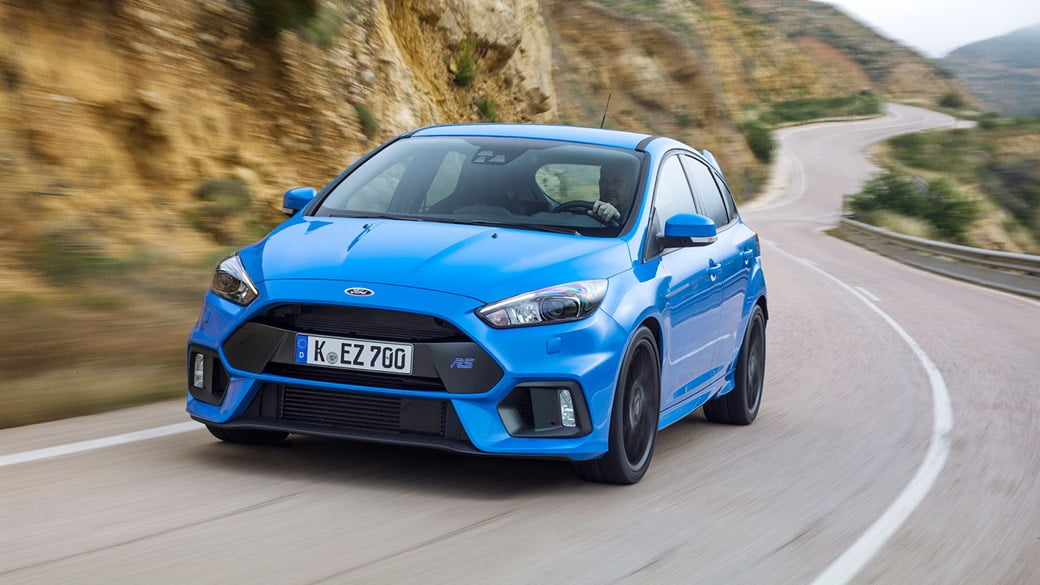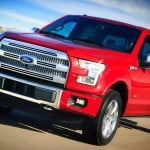
It’s back! But look closely, for the third-generation Ford Focus RS is not quite like anything we’ve ever seen before. Okay, okay, so it is fundamentally quite a lot like all those other Mk3 Focuses you see on the road, everyday – the Focus is after all consistently one of the top three best-selling cars in the UK, and the RS comes down the same production line as all the rest of them. It has five doors, it will tolerate the school run, and it isn’t actually going to eat your children, no matter how much that gaping grille and aggressive aero suggests it might.
And yet… this is a Focus with 345bhp and a four-wheel drive system so smart it seems to know what you want to do before you do. Is this Fast Ford 2.0?
Hit me with the stats on the new Ford Focus RS
That 345bhp comes from an enhanced version of the 2.3-litre Ecoboost petrol fitted in the latest Mustang. The 39bhp increase over the 306bhp Mustang engine is achieved via an upgrade to the turbo, bore liners and Cosworth cylinder head, plus an optimised intake and high-flow exhaust. Peak torque is 324lb ft 2000-4500rpm, with an 18sec overboost function to 347lb ft over the same rev duration if you really lay on the lead booties.
Attention-to-detail nuggets include the way the air intake is sealed at the top by the bonnet, meaning that when the new RS is put on a dyno with the bonnet up, the intake opening is much larger – compensating for the missing charge effect you get when the car is in motion, ensuring it breathes properly when revved up but stationary. This stuff matters to fast Ford fans, and it apparently matters to the team that built the RS, too.
Zero to 62mph takes 4.7sec and top speed is 165mph – both figures that lag behind the RS3 and A45 super hatches from Audi and Mercedes-AMG. But then, the Focus is £10k cheaper, and equipped with a well-oiled six-speed manual gearbox rather than a quick-shifting but involvement-eroding twin-clutch auto; at £29,995 the Focus also matches the price of the less powerful, front-wheel-drive only Honda Civic Type R.
So, what’s special about the four-wheel drive system in the new Focus RS?
The two previous Focus RS models have been front-wheel drive, with the return to all-wheel drive – last seen in the heady days of the Escort Cosworth – prompted by the desire to fully control the potential performance of that tweaked engine. And we do mean fully control; Ford tried the conventional Haldex system used by both German rivals and was left unimpressed by the dynamic limitations of simply shuffling the torque front and rear.
Instead, the RS uses a specially developed GKN system that deploys a pair of clutch packs on the rear axle, enabling the car to distribute torque between the rear wheels in an extremely active manner. The setup is so dynamic that it can send 100% of the torque at the rear to a single rear wheel. Ford officially says there’s a maximum overall rear bias of 70%, but in testing figures above 90% were recorded, depending on the circumstance.
What’s the advantage of using this torque vectoring rear axle?
With a dedicated ECU monitoring steering, throttle, engine output and speed, yaw rate, lateral and longitudinal vehicle acceleration, the brakes and stability control system, the front power transfer unit (which sends the torque to the rear axle), and the rear drive unit (which splits the torque front and rear) 100 times a second, the rear drive unit essentially gives Ford the opportunity to produce a hot hatch that behaves like ‘a rear-wheel-drive car with an enormous amount of grip’.
Making the most of this requires not only a great deal of traditional chassis engineering but also some seriously complex software calibration. As a result, in addition to the ‘dual-mode’ dampers – a massive 40% stiffer in the firmer setting – the bespoke steering knuckles, the extra body bracing and 350mm Brembo front brakes (the largest ever fitted to an RS), the Focus offers four distinct driving modes: Normal, Sport, Drift and Track. Each of these is defined by the behaviour of the four-wheel-drive system, as well as the usual adjustments in steering weighting, throttle response and noise.
Sounds… complicated
It is. Which makes it all the more remarkable that to drive, the Focus is fundamentally intuitive – despite being bonkers fast and, when prompted, decidedly frisky. Paired with slightly greasy roads, the rear-drive element of this family-friendly projectile couldn’t be more obvious. Even before you’ve switched the stability control to its more lenient setting, the RS is eager to get that back end working; in ESC Sport it instantly offers easy-peasy lift-off adjustment and showboating slithers of corner-exit power oversteer.
The degree of slip increases with each driving mode – making Drift as outrageous as the name suggests, especially if you disengage the ESC entirely – until you reach Track, which refocuses (no pun intended) to deliver maximum forward momentum.
Sounds… scary
It absolutely isn’t. Such is the transparency with which the available cornering attitudes are communicated you find yourself reacting instinctively. What’s more, if you aren’t in the mood to muck about, this clever combo of software and hardware can also generate staggering grip. Understeer is fiercely resisted in every situation, helped by a front end that features the same torque vectoring by brake trickery as the Fiesta ST. If you wanna just go, the Focus RS really goes.
Similarly, the Normal setting is handy for pretending to be a responsible parent when dropping off the kids – not least because it puts the cork back into the exhaust. The WRC-grade popping and banging in the other modes is deeply amusing, but probably not conducive to harmonious neighbourhood relations.
What’s the new Focus RS like on the road?
Enormously impressive. It’s tricky to get anywhere near the car’s limits (assuming you haven’t prodded the ‘Drift’ button, at any rate), but you can certainly feel the rear axle at work; it doesn’t feel like a front-wheel-drive car at all – which is a triumph, and immediately makes the RS stand out in a sector already populated with so much exciting machinery.
As you’d expect of a fast Ford, the control weights are beautifully judged, too. Including the super-accurate steering, which leads a front end that’s as pointy as the Fiesta ST and benefits from a specially developed fixed-ratio rack. The downside, also in-keeping with fast Ford tradition, is that the turning circle is rubbish. Unless you’re doing a donut. Obviously.
Ride quality is on the firm side of acceptable, even with the two-stage dampers set to their most compliant ‘Normal’ setting – no wonder the firmer setting is only activated by default in Track mode (you can access it at any time via a button on the end of the indicator stalk). But while it’s noticeably less comfortable than the Golf R, the RS manages to avoid feeling unsettled or unpredictable on bumpier roads, another trick it carries over from the Fiesta ST. Simply put, it’s stonking.
Verdict
The interior’s plain functionality, enlivened only by bucket seats, blue contrast stitching and neon-needled dials, may not stand comparison to the mega-Germans, with their extra horsepower and premium machismo.
But the new Focus RS puts the driver right at the centre of the action, even as it also comes equipped with a technological handling solution that far outstrips anything else in this sector. It makes the Type R seem silly, the Golf R seem staid and everything that outguns it seem eye-wateringly expensive.
[“source-carmagazine”]





